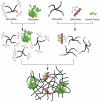Differential effects of substrate modulus on human vascular endothelial, smooth muscle, and fibroblastic cells
- PMID: 22374788
- PMCID: PMC3351091
- DOI: 10.1002/jbm.a.34075
Differential effects of substrate modulus on human vascular endothelial, smooth muscle, and fibroblastic cells
Abstract
Regenerative medicine approaches offer attractive alternatives to standard vascular reconstruction; however, the biomaterials to be used must have optimal biochemical and mechanical properties. To evaluate the effects of biomaterial properties on vascular cells, heparinized poly(ethylene glycol) (PEG)-based hydrogels of three different moduli, 13.7, 5.2, and 0.3 kPa, containing fibronectin and growth factor were utilized to support the growth of three human vascular cell types. The cell types exhibited differences in attachment, proliferation, and gene expression profiles associated with the hydrogel modulus. Human vascular smooth muscle cells demonstrated preferential attachment on the highest-modulus hydrogel, adventitial fibroblasts demonstrated preferential growth on the highest-modulus hydrogel, and human umbilical vein endothelial cells demonstrated preferential growth on the lowest-modulus hydrogel investigated. Our studies suggest that the growth of multiple vascular cell types can be supported by PEG hydrogels and that different populations can be controlled by altering the mechanical properties of biomaterials.
Copyright © 2012 Wiley Periodicals, Inc.
Figures





Similar articles
-
Evaluation of hydrogel matrices for vessel bioplotting: Vascular cell growth and viability.J Biomed Mater Res A. 2016 Mar;104(3):577-585. doi: 10.1002/jbm.a.35590. Epub 2015 Oct 29. J Biomed Mater Res A. 2016. PMID: 26474421
-
Compressive elasticity of three-dimensional nanofiber matrix directs mesenchymal stem cell differentiation to vascular cells with endothelial or smooth muscle cell markers.Acta Biomater. 2012 Apr;8(4):1440-9. doi: 10.1016/j.actbio.2011.12.032. Epub 2012 Jan 8. Acta Biomater. 2012. PMID: 22266031 Free PMC article.
-
Interplay of anionic charge, poly(ethylene glycol), and iodinated tyrosine incorporation within tyrosine-derived polycarbonates: Effects on vascular smooth muscle cell adhesion, proliferation, and motility.J Biomed Mater Res A. 2010 May;93(2):505-14. doi: 10.1002/jbm.a.32544. J Biomed Mater Res A. 2010. PMID: 19585568 Free PMC article.
-
The influence of poly(n-butyl acrylate) networks on viability and function of smooth muscle cells and vascular fibroblasts.Clin Hemorheol Microcirc. 2012;52(2-4):283-94. doi: 10.3233/CH-2012-1605. Clin Hemorheol Microcirc. 2012. PMID: 22960303
-
Incorporation of phosphate group modulates bone cell attachment and differentiation on oligo(polyethylene glycol) fumarate hydrogel.Acta Biomater. 2012 Apr;8(4):1430-9. doi: 10.1016/j.actbio.2011.12.031. Epub 2012 Jan 8. Acta Biomater. 2012. PMID: 22277774 Free PMC article.
Cited by
-
Functional characterization of iPSC-derived arterial- and venous-like endothelial cells.Sci Rep. 2019 Mar 7;9(1):3826. doi: 10.1038/s41598-019-40417-9. Sci Rep. 2019. PMID: 30846769 Free PMC article.
-
Design of thiol-ene photoclick hydrogels using facile techniques for cell culture applications†Electronic supplementary information (ESI) available. See DOI: 10.1039/c4bm00187gClick here for additional data file.Biomater Sci. 2014 Nov 30;2(11):1612-1626. doi: 10.1039/c4bm00187g. Epub 2014 Sep 1. Biomater Sci. 2014. PMID: 25717375 Free PMC article.
-
Human Adventitial Fibroblast Phenotype Depends on the Progression of Changes in Substrate Stiffness.Adv Healthc Mater. 2020 Apr;9(8):e1901593. doi: 10.1002/adhm.201901593. Epub 2020 Feb 27. Adv Healthc Mater. 2020. PMID: 32105417 Free PMC article.
-
Dually degradable click hydrogels for controlled degradation and protein release.J Mater Chem B. 2014;2(34):5511-5521. doi: 10.1039/c4tb00496e. J Mater Chem B. 2014. PMID: 25908977 Free PMC article. No abstract available.
-
Decreasing matrix modulus of PEG hydrogels induces a vascular phenotype in human cord blood stem cells.Biomaterials. 2015 Sep;62:24-34. doi: 10.1016/j.biomaterials.2015.05.021. Epub 2015 May 15. Biomaterials. 2015. PMID: 26016692 Free PMC article.
References
-
- Fitzgibbon GM, Kafka HP, Leach AJ, Keon WJ, Hooper GD, Burton JR. Coronary bypass graft fate and patient outcome: angiographic follow-up of 5,065 grafts related to survival and reoperation in 1,388 patients during 25 years. J Am Coll Cardiol. 1996;28(3):616–26. - PubMed
-
- Motwani JG, Topol EJ. Aortocoronary saphenous vein graft disease: pathogenesis, predisposition, and prevention. Circulation. 1998;97(9):916–31. - PubMed
-
- Peyton SR, Raub CB, Keschrumrus VP, Putnam AJ. The use of poly(ethylene glycol) hydrogels to investigate the impact of ECM chemistry and mechanics on smooth muscle cells. Biomaterials. 2006;27(28):4881–93. - PubMed
Publication types
MeSH terms
Substances
Grants and funding
LinkOut - more resources
Full Text Sources
Other Literature Sources

